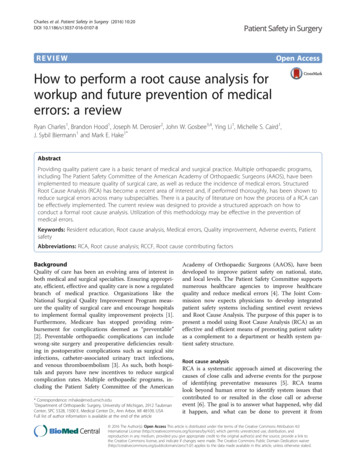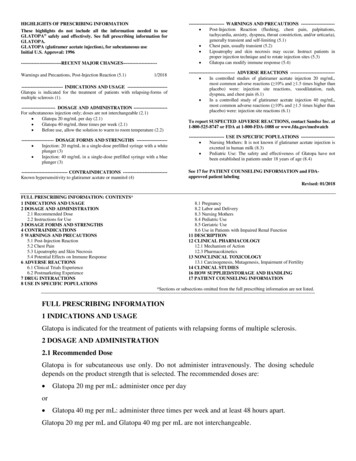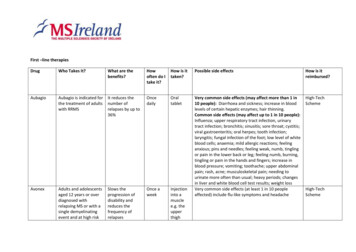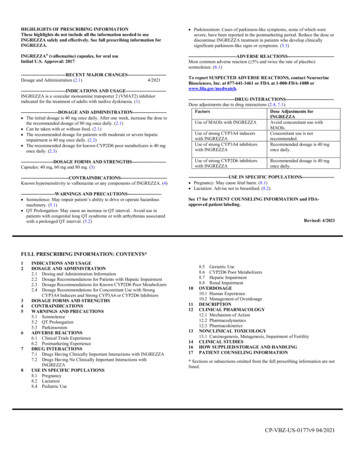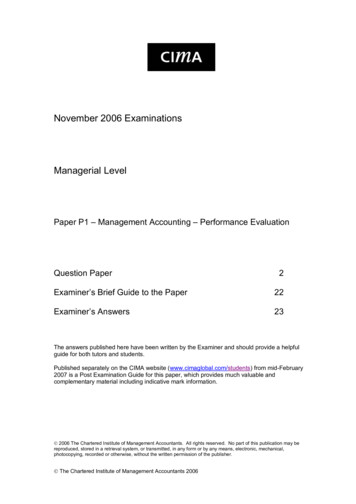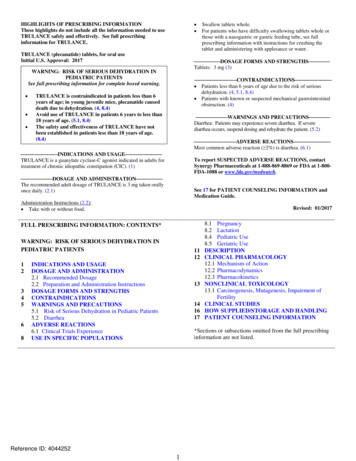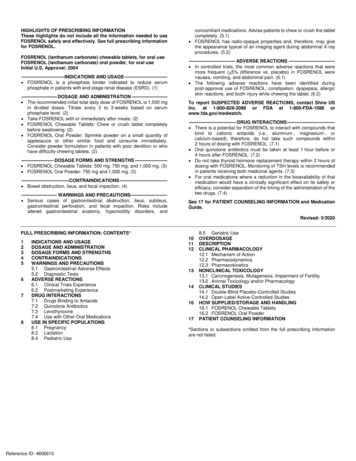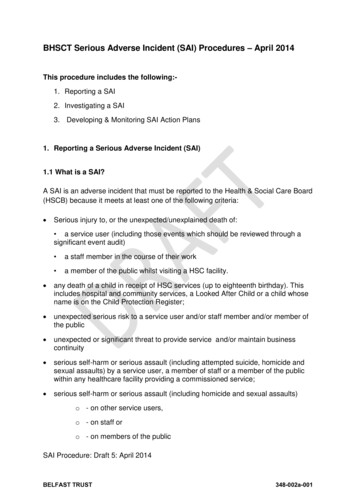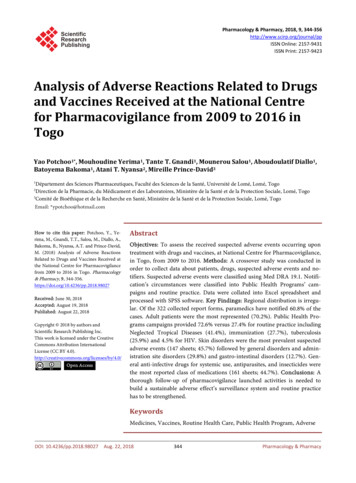
Transcription
Pharmacology & Pharmacy, 2018, 9, 344-356http://www.scirp.org/journal/ppISSN Online: 2157-9431ISSN Print: 2157-9423Analysis of Adverse Reactions Related to Drugsand Vaccines Received at the National Centrefor Pharmacovigilance from 2009 to 2016 inTogoYao Potchoo1*, Mouhoudine Yerima1, Tante T. Gnandi1, Mounerou Salou1, Aboudoulatif Diallo1,Batoyema Bakoma1, Atani T. Nyansa2, Mireille Prince-David3Département des Sciences Pharmaceutiques, Faculté des Sciences de la Santé, Université de Lomé, Lomé, TogoDirection de la Pharmacie, du Médicament et des Laboratoires, Ministère de la Santé et de la Protection Sociale, Lomé, Togo3Comité de Bioéthique et de la Recherche en Santé, Ministère de la Santé et de la Protection Sociale, Lomé, Togo12How to cite this paper: Potchoo, Y., Yerima, M., Gnandi, T.T., Salou, M., Diallo, A.,Bakoma, B., Nyansa, A.T. and Prince-David,M. (2018) Analysis of Adverse ReactionsRelated to Drugs and Vaccines Received atthe National Centre for Pharmacovigilancefrom 2009 to 2016 in Togo. Pharmacology& Pharmacy, 9, ved: June 30, 2018Accepted: August 19, 2018Published: August 22, 2018Copyright 2018 by authors andScientific Research Publishing Inc.This work is licensed under the CreativeCommons Attribution InternationalLicense (CC BY en AccessAbstractObjectives: To assess the received suspected adverse events occurring upontreatment with drugs and vaccines, at National Centre for Pharmacovigilance,in Togo, from 2009 to 2016. Methods: A crossover study was conducted inorder to collect data about patients, drugs, suspected adverse events and notifiers. Suspected adverse events were classified using Med DRA 19.1. Notification’s circumstances were classified into Public Health Programs’ campaigns and routine practice. Data were collated into Excel spreadsheet andprocessed with SPSS software. Key Findings: Regional distribution is irregular. Of the 322 collected report forms, paramedics have notified 60.8% of thecases. Adult patients were the most represented (70.2%). Public Health Programs campaigns provided 72.6% versus 27.4% for routine practice includingNeglected Tropical Diseases (41.4%), immunization (27.7%), tuberculosis(25.9%) and 4.5% for HIV. Skin disorders were the most prevalent suspectedadverse events (147 sheets; 45.7%) followed by general disorders and administration site disorders (29.8%) and gastro-intestinal disorders (12.7%). General anti-infective drugs for systemic use, antiparasites, and insecticides werethe most reported class of medications (161 sheets; 44.7%). Conclusions: Athorough follow-up of pharmacovigilance launched activities is needed tobuild a sustainable adverse effect’s surveillance system and routine practicehas to be strengthened.KeywordsMedicines, Vaccines, Routine Health Care, Public Health Program, AdverseDOI: 10.4236/pp.2018.98027Aug. 22, 2018344Pharmacology & Pharmacy
Y. Potchoo et al.Events Reporting, Pharmacovigilance1. IntroductionPharmacovigilance (PV) is a science and activities relating to the detection, assessment, understanding and prevention of adverse effects (AE) or any othermedicine-related problems. Its objectives are 1) preventing harm from adversereactions in humans, arising from the use of authorized medicinal productswithin or outside the terms of marketing authorization or from occupationalexposure and 2) promoting the safe and effective use of medicinal products, inparticular through providing timely information about the safety of medicinalproducts to patients, healthcare professionals and the public [1].Uppsala Monitoring Center (UMC), an independent and international research center affiliated to the World Health Organization (WHO), is the structure in charge of the monitoring medicines and promoting their adequate usesince 1978 [2].In sub-Saharan Africa, few studies covering a wide range of fields of the adverse events reporting process have been published. Ampuda et al., analyzingspontaneous reports in VigiBase reported the following data: the main class ofproducts in African Individual Case Safety Reports (ICSRs) includes the treeclasses of reverse transcriptase inhibitors (23.13%), antivirals for the treatmentof HIV infections (5.50%), combinations of sulfonamides and trimethoprim(2.98%) and angiotensin-converting enzyme (ACE) inhibitors (2.42%). Themain product classes implicated in ICSRs from the rest of world are tumour necrosis factor-a (TNFa) inhibitors (5.29%), topical nonsteroidal anti-inflammatorypreparations (2.26%), selective immunosuppressants (2.08%), selective serotoninreuptake inhibitors (2.04%) and 3-hydroxy-3-methylglutaryl-coenzyme (HMGCoA) reductase inhibitors (1.85%). The main SOCs reported from Africa versusthe rest of world include skin and subcutaneous tissue disorders (31.14% vs.19.58%), general disorders and administration site conditions (20.91% vs.30.49%) and nervous system disorders (17.48% vs. 19.13%) [3].In Togo, PV activities started in 2006. Information about AEs are gatheredand recorded as cases on report forms (RFs), through reporters all over thecountry and are evaluated by a technical committee. Each case is assessed in order to establish a causal link between the observed AEs and the drugs’ consumption. Once analyzed, cases are shared at a global level through VIGIFLOW , onone hand and with the reporters as feedback on the other hand, at the nationallevel.The PV system of Togo was, organized by the implementation of regulatorytools (creation decree), technical tools (RF, notification guide, assessment guide,supervision form, summary form) and human resources (national pharmacovigilance focal point, regional and district focal points, focal points in Hospitals)DOI: 10.4236/pp.2018.98027345Pharmacology & Pharmacy
Y. Potchoo et al.[4], from 2006 to 2011.From January 2012 to May 2016, the National Centre for Pharmacovigilance(NCPV) did not organize any major activity due to lack of human resources [4].The primary aim of this study, the first one in this topic in Togo, is to describethe collected notifications at the NCPV from 2009 to 2016. The secondary aimsare to 1) assess the impact of follow up on the quality of the PV system, 2) describe the subgroups of data (patient, drug, AE and reporters) existing on theRFs, 3) identify the associated factors to AEs reporting in Togo.2. Methods2.1. Study DesignThe received RFs at the NCPV, from 2009 to 2016, from Togo reporters, following Figure 1 circuit were included in our study. The RFs sent to the NCPVconcerning cases occurring in other countries of the world have not been included.2.2. Data Collection and AnalysisEighteen (18) fields were collected from national adverse events reporting formfor vaccines and other drugs. In comparison, adverse events reporting form forvaccines include 41 fields of which 12 are obligatory [5] and that for others medicines includes 33 fields [6]. The national reporting form required the followingdata:Healthcare units- VaccinationSiteDistrictPharmacovigilanceFocal PointRegionalPharmacovigilanceFocal PointNational Centre forPharmacovigilanceFigure 1. Adverse effect notification circuit in Togo.DOI: 10.4236/pp.2018.98027346Pharmacology & Pharmacy
Y. Potchoo et al.1) General data: year of notification;2) Reporter data: profile, facility of practice, address/contact, regional area;3) Patient data: age, sex, address, previous relevant medical conditions, laboratory investigations;4) Product data: drug or vaccine, International Nonproprietary Name (INN),circumstances of product’s use and;5) Suspect adverse events (SAEs) data: description, onset time, outcome,received treatment, outcome in case of re-administration.Year of notification was used to compare the RFs’ numbers according to 2 periods (2009-2011 and 2012-2016), in order to determine whether the lack of integrated activities impacted the system.The qualitative variables “region” and “reporter” were transformed into quantitative and binary variables.Thus, the three regions of the north (Savannas, Kara, and Central) werenamed as “northern region” and those of the south (uplands, Maritime andLome Commune) as “southern region”.Physicians and pharmacists have been grouped into medics and other healthcare professionals (nurses, health technicians, and midwifes) into paramedics.Patients were divided into two age groups: children (0 to 15 years old) andadults (over 15 years old).Vaccines have been considered as a distinct group from drugs, due to theirexclusively preventive use. The identified INNs of drugs and vaccines were classified in accordance with the Anatomical Therapeutic and Chemical (ATC) nomenclature. The ATC nomenclature entails 14 main anatomical/pharmacologicalgroups or first levels. Each major ATC group is divided into second levels thatcould be either pharmacological or therapeutic groups. The third and fourth levels are chemical, pharmacological or therapeutic subgroups and the fifth level isthe chemical substance. Levels 2, 3 and 4 are often used to identify pharmacological subgroups when it is considered more appropriate than therapeutic orchemical subgroups [7].The collected SAEs were classified according to the severity criteria defined byWHO. A serious AE is defined as an AE which results in death, is life-threatening,requires in-patient hospitalization or prolongation of existing hospitalization,results in persistent or significant disability or incapacity, or is a congenitalanomaly/birth defect [1]. No causal assessment was realized thus all the collectedAEs were considered SAEs.Notification circumstances were classified into two groups:1) Routine practice (RP): they concern all the cases notified by healthcareprofessionals in either preventive or curative treatment for common conditions,for all kinds of population;2) Public Health Programs (PHPs) mass treatment campaigns: they includenotifications during campaigns organized by one or more PHPs (HIV, malaria,tuberculosis (TB), immunization), as a preventive measure, towards a specifictarget population.DOI: 10.4236/pp.2018.98027347Pharmacology & Pharmacy
Y. Potchoo et al.Suspect adverse events were coded according to the terminology of the Medical Dictionary for Regulatory Activities (MedDRA 19.1) [8]. It is an international medical terminology developed at the initiative of the International Conference on Harmonization (ICH), regarding the technical requirements for theregistration of pharmaceuticals for human use. The codes refer to a group ofMedDRA terms belonging to the primary system organ class (SOC). The SOC isa medical discipline classification.Data was treated and analyzed with MICROSOFT Excel software 2013 SPSSsoftware. The student test was used to compare the number of RF before and after 2012. The chi-2 test was used in the analysis of data and Fischer’s exact testwhen the number was less than 5. The significance threshold was set at 5%.2.3. Ethical ConsiderationsPatients and reporters’ personal data were anonymous to preserve their confidentiality. The local Ethics Committee authorization was then, not required.3. Results3.1. General DataA total of 322 RFs were collected from 2009 to 2016 (range 4 - 96, average 35.78 33.43, median 27).The completeness of the 18 fields on the 322 RFs is presented in Table 1.Table 1. Data completeness (n 322).Datan%Patient age31999.1Patient sex322100.0Laboratory investigations Information10.3Patient address30494.4Patient’s previous medical relevant conditions4413.7Patient contact16450.9Product name322100.0Product’s use circumstances30394.1Adverse Effect32199.7Adverse Effect onset time29892.6Adverse Effect outcome22469.6Outcome in case of re-use123.7Product withdrawal information5517.7Adverse Effect management16150.0Reporter’s profile29090.1Reporter’s contact31898.8Reporter’s region31898.8Year of notification31798.4n Number of reports; % Frequency.DOI: 10.4236/pp.2018.98027348Pharmacology & Pharmacy
Y. Potchoo et al.Eleven (11) fields out of 18 were filled out on more than 90% of report forms.Three (3) out of 18 fields were filled out in more than 50% of the RFs and theremaining 4 fields were filled out on less than 20% of the RFs.The distribution of RFs received, per year is shown on Figure 2 with a significant decrease from 2012 to 2013, compared to the period before (p 0.05).Notifiers’ profiles are shown in Table 2. Paramedics reported two times(60.9%) more than medics (29.2%).The notifier’s profiles by regional area of practice are shown on Table 3. Thenumber of medics’ RFs is 15 folds higher in the southern region than in thenorthern region of the country (56.5% vs. 3.7%). As for paramedics’, they reported two times more cases in the northern region than in the southern region(80.5% vs. 40.3%).3.2. Patient DataMales predominance was recorded, with 169 men out of 322 (52.5%) and amale/female sex ratio of 1.1.Patients’ ages ranged from 0.08 to 84 years old (28.31 18.80, median 27.0years).Table 4 shows the distribution of notifier profiles by patient age group. RFsfor adult patients were higher than those for children (70.2% versus 28.9%; p 0.001).3.3. Suspect Drugs of Adverse EventsThere were 243 RFs for medicines (74.5%), and 79 (25.5%) for vaccines. Eighty-three (83) RFs (25.8%) were reported in routine practice while PHP campaigns resulted in 220 (74.2%) notifications.Several public health programs have been identified as shown in Table 5:neglected tropical diseases (41.4%), immunization (27.7%), tuberculosis (25.9%)and HIV (4.5%).Table 6 shows the most prevalent reported products on the report forms. On3529.83025.2Frequency 09201020112016YearsFigure 2. Report forms distribution per year (n 317).DOI: 10.4236/pp.2018.98027349Pharmacology & Pharmacy
Y. Potchoo et al.Table 2. Notifiers profile.ProfileNumberFrequency tal322100.0Table 3. Notification distribution regarding to the notifier patterns and practice 1.2Total9429.219660.9329.9322100.0n number; % frequency.Table 4. Notifiers distribution according to the notifiers’ profiles and patient age %n%n%[0; 15]33.27378.51718.39328.9[15; 00.030.9Total9429.219660.9329.9322100.0n headcount; % percentage.Table 5. Report forms distributions by public health programs (n 220).Public health programsNumberFrequency (%)Blindness10.5Neglected tropical HIV104.5Total220100.0the 322 collected report forms, 360 products were collected (1.1 product per report form). SAEs concerned mainly ivermectine (20.5%), praziquantel (17.7%),RHZE (15.8%) and ACWY135 (15.5%).Table 7 presents the first level ATC group of the notified products. Anti-infectives for systemic use (44.7%), pest control, insecticides (28.9%) and cardiovascular system (11.9%) were the main tree groups more frequently suspected.DOI: 10.4236/pp.2018.98027350Pharmacology & Pharmacy
Y. Potchoo et al.Table 6. Most common medicines reported on forms.INNHeadcountFrequency Y1355015.5Captopril134.0Amlodipine113.4D T C P HIB2 Vaccine113.4Inactive fragmented Influenza vaccine113.492.8MetforminRHZE: Rifampicin Isoniazid Pyrazinamide Ethambutol; VACCINE D T C P HIB: Pentavalent vaccine against diphtheria, tetanus, whooping cough, poliomyelitis and Haemophilus influenzae type b;INN: International nonapropriatery name.2Table 7. Distribution of drug groups according to the first level of ATC classification (n 360).ATC main groupNumberFrequency (%)(J) Anti-infectives drugs for systemic use16144.7(P) Pest Control, Insecticides10428.9(C) Cardiovascular system4311.9(A) Digestive tract and metabolism215.8(N) Nervous system164.4(B) Blood and hematopoietic organs82.2M) Muscle and skeleton30.8(R) Respiratory system30.8(H) Systemic Hormones, Excluded Sex Hormones10.3ATC: anatomical therapeutic and chemical.3.4. Suspect Adverse Effects ClassificationTable 8 shows the distribution of notifications, based on reporters and the seriousness of the SAE. Non serious SAEs represented 83.5% against serious SAEs(16.5%). Medics notified 32.1% serious SAEs vs. 28.6% non-serious SAEs whileparamedics notified 62.5% non-serious SAEs vs. 52.8% serious SAEs. There is nostatistical link between the behavior of both medics and paramedics, in case ofserious or non-serious SAEs (p 0.40).Table 9 presents the SOC codes of suspect adverse event by frequency. By decreasing frequency reporting concerned skin and subcutaneous tissue disorders(45.7%) followed by general disorders and administration site conditions(29.8%), nervous system disorders (17.1%), gastro-intestinal disorders (17.1%)and musculoskeletal and systemic disorders (7.8%).DOI: 10.4236/pp.2018.98027351Pharmacology & Pharmacy
Y. Potchoo et al.Table 8. Notifications distribution, according to the reporters and the seriousness of theadverse drug on 3.300.030.9Total9429.219660.9329.9322100.0n number; % percentage.Table 9. Ten most common suspect adverse events according to the system organ class.System organ classNumber of sheetFrequency (%)Skin and subcutaneous tissue disorders14745.7General disorders and administration site conditions9629.8Nervous system disorders5517.1Gastro-intestinal disorders4112.7Musculoskeletal and systemic disorders257.8Eye disorders175.3Renal and urinary disorders165.0Disorders of reproductive organs and breast134.0Immune system disorders113.4Respiratory, thoracic and mediastinal disorders92.84. DiscussionStudy limitsPharmacovigilance activities were launched in 2007; our study was conductedfrom 2009 due to loss of the RFs before 2009.The causal assessment was not realized because the available data were notsufficient for the assessment of all the cases.The history of Public Health Programs’ Campaigns was not available to allowus to assess whether the RFs distribution was proportional or not to treated population.Pharmacovigilance activities were launched in 2007 in Togo with the adventof the strategies from World Health Organisation (WHO) to introduce PVthrough the PHPs in Africa (collaborations with malaria, HIV, TB, neglecteddiseases) [9].Three hundred and twenty-two (322) reports were filled from 2009 to 2016(range 4 - 96, average 35.78, median 27). Compared with the number of spontaneous reports (556) received at Uganda’s NCPV for the first 5 years from 2005 toDOI: 10.4236/pp.2018.98027352Pharmacology & Pharmacy
Y. Potchoo et al.2009 [10], our results confirm an under-reporting of our PV system that couldbe explained by the weakness of the system.Concerning the completeness of the filled fields, eleven (11) out of 18 fieldswere filled on more than 90% of the report forms. Three (3) out of 18 fields werefilled in more than 50% of the RFs and notifications and the remaining 4 fieldswere less than 20% of them. This high rate of completeness of forms is explainedby the validation of report forms established by the NCPV team. The pharmacovigilance focal points were trained to validate the report forms and to transmitonly those which had a sufficient level of data, to make the record usable [4].The significant drop down of the number of RFs from 2012 to 2013 can be explained by the lack of human resources at the NCPV during the period from2009 to 2016 [4].Medics’ reports from the southern part of the country are 15 folds that fromthe northern part whereas paramedics’ reports from the northern region are twofolds that from the southern. This can be explained by the concentration ofmedics in the South of the country and paramedics in the North.A predominance of males is recorded in our study with 52.5% while identicalproportions of females (57% Africa and the rest of world) and males (37% Africaand the rest of world) were reported from VigiBase [3]. That difference relatedto our result could be explain by the fact of hazard. Our results show that reportforms in adult patients represented two third against one third in children. Carbonin et al. [11] and Bégaud et al. [12] also have noticed that the notificationrate increased with age. This result confirm that of Ampadu et al., who reportedthat the 18 - 44 years age group dominated individual case safety reports (ICSRs)from Africa, while the 45 - 64 years age group dominated the rest of the world[3].One third of report forms were carried out during routine practice while PHPcampaigns resulted in two third notifications. A possible explanation may be therigorous monitoring of activities implemented by PHP during their campaigns.There is no statistical link between the behavior of both medics and paramedics, in case of serious or non-serious SAEs.General anti-infectives drugs for systemic use, antiparasitic agents and insecticides, cardiovascular system and digestive tract and metabolism were thepharmacological groups of the most reported drugs in our study. The most frequently mentioned medication classes associated with ADRs in the past 4 weeksin Uganda were antibiotics (38%), antiretroviral agents (23%), antimalarials(15%, 15 of which implicated quinine), analgesics (9%) and others (15%) [10].The main class of products in African ICSRs are nucleoside and nucleotide reverse transcriptase inhibitors (14.04%), nonnucleoside reverse transcriptase inhibitors (9.09%), antivirals for the treatment of HIV infections (5.50%), combinations of sulfonamides and trimethoprim (2.98%) and angiotensin-convertingenzyme (ACE) inhibitors (2.42%). Compared to the rest of the world, the mainproduct classes implicated in ICSRs are tumour necrosis factor-a (TNFa) inhiDOI: 10.4236/pp.2018.98027353Pharmacology & Pharmacy
Y. Potchoo et al.bitors (5.29%), topical non-steroidal anti-inflammatory preparations (2.26%),selective immunosuppressants (2.08%), selective serotonin reuptake inhibitors(2.04%) and HMG CoA reductase inhibitors (1.85%) [3]. Our study results areconsistent with the epidemiological context of the country. The SAEs reported(skin and sub cutaneous tissue disorders, general disorders and administrationsite conditions, nervous system disorders, gastro-intestinal disorders, musculoskeletal and systemic disorders ) can be related to main adverse effects reported in literature for anti-infectives drugs for systemic use such as: ivermectine(pruritus, edema, arthralgia, headache, popular eruptions) [13]; praziquantel(nausea and abdominal pain or discomfort, headache, giddiness or drowsiness)[14]; RHZE (gastric intolerance, skin changes, join pain) [15] and vaccineACWY 135 (headache, fatigue, soreness, erythema) [16]. Furthermore, in astudy among inpatients, Fofana et al. [17], reported similar SOCs excluding metabolic disorders such as skin (47.33%), metabolic (22.14%), neuromuscular(10.68%) and digestive (8.4%). The drugs implicated in skin adverse reactions inthis study (causal link established) were sulfonylurea (47.37%), penicillin(13.16%), non-steroidal anti-inflammatory agents (13.16%) or tramadol (7.89%).The difference observed in the two study could be due at least to the sitting (national vs hospital) and the eligible population (all individual vs inpatients). Related to international data, the main SOCs reported from Africa versus the restof world include skin and subcutaneous tissue disorders (31.14% vs. 19.58%),general disorders and administration site conditions (20.91% vs. 30.49%) andnervous system disorders (17.48% vs. 19.13%) [3]. The main SOCs profile of ourfindings is similar to that reported from Africa.5. ConclusionsIn conclusion, this cross-sectional study conducted on SAEs’ notifications inTogo, pointed out that paramedics are more involved in PV activities than medics. Public health program campaigns had led to more notifications than routinepractice. Regional notifications distribution is neither equal nor proportional tothe population showing heterogeneous practices among professionals. The lackof human resources from 2012 to 2016 created a significant dropdown in the notification rate.The most frequently affected SOC was the skin disorders and the subcutaneous tissue were the most frequently reported.Among the ATC classes of the drugs with the highest number of RFs, the mostimportant are the general anti-infectives drugs for systemic use and antiparasitics and insecticides including the implication of the Ivermectin, Praziquantel,the association RHZE and ACYW135 vaccine.Overall, the analysis of the results revealed some important determining factors. Statistically significant factors were the area of exercise, the age of the patient, health product consumption circumstance and the type of health products.These determining factors could lead to some interventions to strengthen thenational pharmacovigilance system.DOI: 10.4236/pp.2018.98027354Pharmacology & Pharmacy
Y. Potchoo et al.Conflicts of InterestThe authors declare no conflicts of interest regarding the publication of this paper.References[1]European Medicines Agency (2017) Guideline on Good Pharmacovigilance Practices (GVP). Annex I—Definitions (Rev 4). EMA/876333/2011 Rev 4, 22.http://www.ema.europa.eu/docs/en GB/document library/Scientific guideline/2013/05/WC500143294.pdf[2]Pajot, F. (2005) Objectifs et méthodes du suivi post-commercialisation d’un médicament. Thèse, Université de Nantes, Faculté de pharmacie, Nantes, 101 p.[3]Ampadu, H., Hoekman, J., de Bruin, M.L., Pal, S.N., Olsson, S., Sartori, D., Leufkens, H.G.M. and Dodoo, A.N.O. (2016) Adverse Drug Reaction Reporting in Africa and a Comparison of Individual Case Safety Report Characteristics betweenAfrica and the Rest of the World: Analyses of Spontaneous Reports in VigiBase.Drug Safety, 39, 335-345. https://doi.org/10.1007/s40264-015-0387-4[4]Centre National de Pharmacovigilance Togo (2011) Trimester Activities Report 4.[5]WHO (2018) Formulaire de notification des manifestations postvaccinales indésirables (MAPI).http://www.who.int/vaccine safety/initiative/tools/AEFI reporting form FR Jan2016.pdf?ua 1[6]WHO (2012) Assurer la sécurité des interventions de chimioprévention pour lalutte contre les maladies tropicales négligées: Conseils pratiques à l’intention desadministrateurs de programmes nationaux sur la prévention, le dépistage, et la priseen charge des événements indésirables graves. /75185/9789242502190 fre.pdf;jsessionid 20B5EEA5A262BED2BBB12288E8011BB8?sequence 1[7]WHO Collaborating Centre for Drug Statistics Methodology Norwegian Institute ofPublic Health (2018) ATC/DDD Principles.https://www.whocc.no/atc/structure and principles/[8]World Health Organization (2018) Essential Medicine and y safety/safety efficacy/pharmvigi/en/[9]Bencheikh, R.S., Ouledghriss, R., Skalli, S. and Alj, L. (2018) PharmacovigilanceSystems in Africa North Africa/Sub-Saharan 9/11/r soulaymani pharmacovigilance-Africa astmh2009.pdf[10] Kiguba, R., Karamagi, C., Waako, P., Ndagije, H.B. and Bird, S.M. (2014) Recognition and Reporting of Suspected Adverse Drug Reactions by Surveyed HealthcareProfessionals in Uganda: Key Determinants. BMJ Open, 4, 9[11] Carbonin, P., Bernabei, R. and Sgadari, A. (1991) Is Age an Independent Risk Factorof Adverse Drug Reactions in Hospitalized Medical Patients? Journal of the American Geriatrics Society, 39, .tb02875.x[12] Bégaud, B., Martin, K., Fourrier, A. and Haramburu, F. (2002) Does Age Increasethe Risk of Adverse Drug Reactions? British Journal of Clinical Pharmacology, 54,550-552. 3] Prod’hom, J., Boussinesq, M., Fobi, G., Prud’hom, J.M., Enyong, P., Lafleur, C. andQuillévéré, D. (1991) Lutte contre l’onchocercose par ivermectine: Résultats d’uneDOI: 10.4236/pp.2018.98027355Pharmacology & Pharmacy
Y. Potchoo et al.campagne de masse au Nord-Cameroun. Bulletin de l’Organisation Mondiale de laSanté, 69, 443-450.[14] Katz, N., Rocha, R.S. and Chaves, A. (1979) Preliminary Trials with Praziquantel inHuman Infections Due to Schistosoma mansoni. Bulletin de l’Organisation Mondiale de la Santé, 57, 781-785.[15] Rabahi, M.F., Rodrigues da Silva, J.J.L., Galvão Ferreira, A.C., Schwartz Tanus-Silva,D.G. and Conde, M.B. (2017) Tuberculosis Treatment. Jornal Brasileiro de Pneumologia, 43, 472-486. ] Ambrosch, F., Wiedermann, G., Crooy, P. and George, A.M. (1983) Immunogenicity and Side Effects of a New Tetravalent Meningococcal Polysaccharide Vaccine.Bulletin de l’Organisation Mondiale de la Santé, 61, 317-323.[17] Fofana, S., Yaméogo, T.M., Zongo, R.F.E., Kyelem, C.G., Ouédraogo, R.W.-L., Diallo, B., Kaboré, L., Sombie, I., Ilboudo, A., Ouédraogo, M., Sanou, B. and Guissou,I.P. (2017) Pharmacovigilance at University Teaching Hospital Souro Sanou: Studyof Spontaneous Reports of Adverse Drug Reactions. World Journal of Pharmaceutical Research, 6, 202-215.DOI: 10.4236/pp.2018.98027356Pharmacology & Pharmacy
2.2. Data Collection and Analysis Eighteen (18) fields were collected from national adverse events reporting form for vaccines and other drugs. In comparison, adverse events reporting form for vaccines include 41 fields of which 12 are obligatory [5] and that for others me-dicines includes 33 fields [6].
